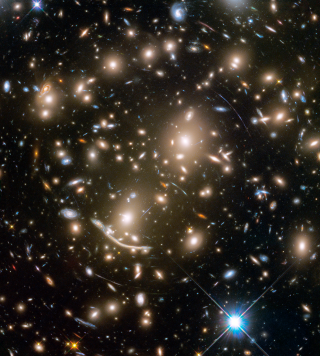Bibcode
Cova, F.; Gastaldello, F.; Wik, D. R.; Boschin, W.; Botteon, A.; Brunetti, G.; Buote, D. A.; De Grandi, S.; Eckert, D.; Ettori, S.; Feretti, L.; Gaspari, M.; Ghizzardi, S.; Giovannini, G.; Girardi, M.; Govoni, F.; Molendi, S.; Murgia, M.; Rossetti, M.; Vacca, V.
Bibliographical reference
Astronomy and Astrophysics, Volume 628, id.A83, 19 pp.
Advertised on:
8
2019
Journal
Citations
29
Refereed citations
28
Description
Aims: We present the results of a joint XMM-Newton and NuSTAR
observation (200 ks) of the galaxy cluster Abell 523 at z = 0.104. The
peculiar morphology of the cluster radio halo and its outlier position
in the radio power P(1.4 GHz) - X-ray luminosity plane make it an ideal
candidate for the study of radio and X-ray correlations and for the
search of inverse Compton (IC) emission. Methods: We constructed
bi-dimensional maps for the main thermodynamic quantities (i.e.,
temperature, pressure and entropy) derived from the XMM observations to
describe the physical and dynamical state of the cluster's intracluster
medium (ICM) in detail. We performed a point-to-point comparison in
terms of surface brightness between the X-ray and radio emissions to
quantify their morphological discrepancies. Making use of NuSTAR's
unprecedented hard X-ray focusing capability, we looked for IC emission
both globally and locally after properly modeling the purely thermal
component with a multi-temperature description. Results: The
thermodynamic maps obtained from the XMM observation suggest the
presence of a secondary merging process that could be responsible for
the peculiar radio halo morphology. This hypothesis is supported by the
comparison between the X-ray and radio surface brightnesses, which shows
a broad intrinsic scatter and a series of outliers from the best-fit
relation, corresponding to those regions that could be influenced by a
secondary merger. The global NuSTAR spectrum can be explained by purely
thermal gas emission, and there is no convincing evidence that an IC
component is needed. The 3σ upper limit on the IC flux in the
20-80 keV band is in the [2.2-4.0] × 10-13 erg
s-1 cm-2 range, implying a lower limit on the
magnetic field strength in the B > [0.23 - 0.31] μG range.
Locally, we looked for IC emission in the central region of the cluster
radio halo finding a 3σ upper limit on the 20-80 keV nonthermal
flux of 3.17 × 10-14 erg s-1
cm-2, corresponding to a lower limit on the magnetic field
strength of B ≳ 0.81 μG.
Related projects

Galaxy Evolution in Clusters of Galaxies
Galaxies in the universe can be located in different environments, some of them are isolated or in low density regions and they are usually called field galaxies. The others can be located in galaxy associations, going from loose groups to clusters or even superclusters of galaxies. One of the foremost challenges of the modern Astrophysics is to
Jairo
Méndez Abreu